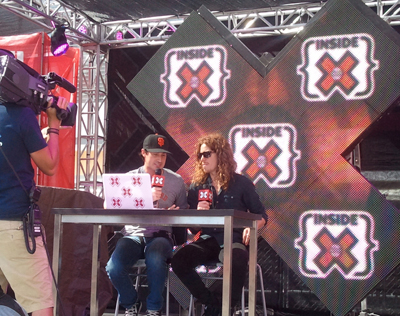To the Edge: Producing and Broadcasting Summer X Games 2011
As a hybrid live/broadcast event, the X Games franchise is the closest thing we have to the Olympics, only better, because ESPN has near-complete control over the events and seems to enjoy taking the "extreme" philosophy at the heart of the games to the limit.
Video And Lights
Summer X Games 17 marked the first time that both the video display monitors and the video signals themselves were all created and displayed in 720p HD, using a Ross switcher to move HD signal throughout the Staples Center and a TriCaster 850 for streaming the other competition sites.
"That was a big relief this year because it meant that the broadcast side didn't have to downconvert the twenty signals they sent to us, or upconvert the three screen feeds I send back to them," explains Sheri Sternberg, the technical director for the live production for ESPN.
Sternberg has worked on X Games shows since 1999 when they were in San Francisco, and now also does the Summer and Winter shows in the U.S. as well as the expanded Winter X Games taking place in France. For her, the challenge of managing a complex live event that also serves a the core of a broadcast that's aired globally lies in managing the technology used to link the venues and the venues to the broadcast. That's even more elaborate this year with a much fuller social media component.
"Adding additional fiber two or three years ago and then using MADI to share audio with our counterparts in TV has helped tremendously," she says. "A combination of technologies like that and as much planning as we're able to put in place ahead of time are what makes it work."
Lighting and Sound in Performance Spaces
One of Sternberg's tasks was to determine proper levels of lighting and sound for each event. The fact that many of the larger events were indoors, such as the Vert in the Nokia Theatre, meant that they could use the house lighting and PA as the core platforms, supplementing gear when needed. In the case of that venue, Sternberg realized that the house lighting design was created to illuminate what took place on stage; the X Games participatory culture meant that the audience also needed to be lit up to some extent, both for the cameras but also for each other.
"Last year the crowd seemed lost, somewhat indistinct, so this year our lighting director David Flad and I discussed adding more moving fixtures and PAR bars," she explains. "We wanted to be able to show individual faces as well as paint the ramp with our signature ‘X' gobos. We took the back lighting all the way to the upstage wall [of the venue] and brought in VariLite VL3500 to complement the existing 3K moving fixtures," that would not only illuminate but also animate the crowds in their seats. This was facilitated by the fact that the Nokia has one of the most elaborate gantry systems found in indoor performing spaces, allowing Sternberg's crews to pull the truss all the way down to the floor, extend it, attach the light fixtures, and raise it back into place.

Interviewing in front of Big X
The Big Air jump in Lot 7 was an outdoor venue lit using three Musco Lighting trucks, each with 15 remote controlled 6K HMI fixtures. These were the primary sources for the campus' exterior lighting. The challenge here is to light the ramp consistently from the drop in at 80-plus feet high to the flat bottom only inches from the asphalt. The lights had to provide enough coverage so that what the camera long shots saw was a single proposition made up of daunting jumps, slopes and tracks, riders seemingly oblivious to the dangers, and thousands of audience members cheering them on. With only minimal budget for theatrical lighting, colorblazes lined the start area, and showguns were brought in to highlight the ramp features, "They are the only fixtures that will read over the footcandles of the Musco trucks," Sternberg adds.
Lighting the Summer X Games requires more subtlety than brute force, with some lighting used to create color washes across the sun-drenched L.A. Live campus, where sunshine tends to cooperate with the crews and where you can still read a newspaper in the 8:30 p.m. daylight as that day's show wound down. "For the Winter X Games, some of the events don't even start until 6 pm, when it's already dark," says OSA senior staff engineer Brian Daily. "So the lighting for that is an entirely different thing."